If you need to get anywhere in Chicago, there’s one way you can pretty much almost always count on–the CTA. In particular, the CTA bus system will get you most anywhere you need to go.
In this post, we provide a guide to riding the CTA, from available routes, to fares, to riding etiquette and safety. Read on to learn everything you need to know about riding the CTA!
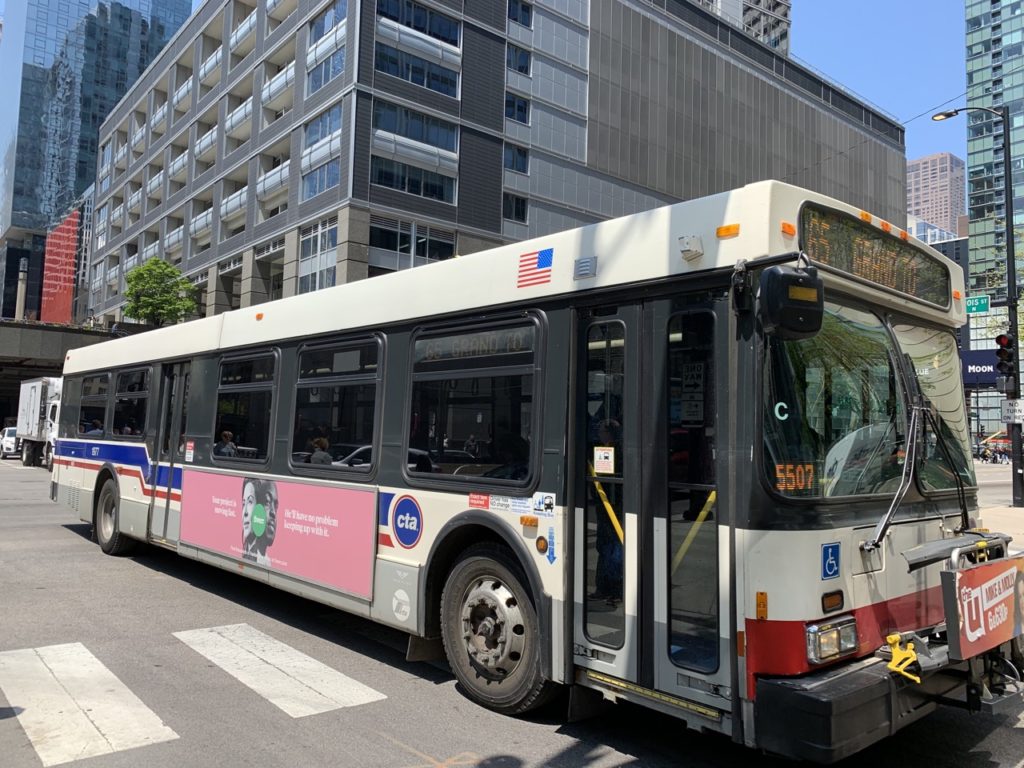
The Chicago Transit Authority (“CTA”) operates buses and trains in Chicago. This post is a companion post to our Guide to Riding the L Train System in Chicago. That post focuses mostly on riding L trains—the train component of the CTA system. This post focuses primarily on buses.
CTA Bus Hours and Coverage
Buses have a wide range of operating hours, from routes that run 24 hours to routes that run only for a few hours during rush periods. For this reason, it’s important to always check route hours if you’re using something like Google Maps to plan your trip, as Google Maps will always provide you options based on a set departure time (which is by default set to the current time).
CTA buses reach pretty much the entire city. You can view the entire system map here and see that every commercial or residential spot in the city is within a mile of a bus route.
Because of its grid system, you can often get anywhere you need to go in the city by taking one bus east/west and one bus north/south. For longer distances, it will usually be more convenient to use the L train system for some segment of your journey.
Basics of CTA Bus Route Numbering and Naming
Every CTA bus route has a number and name. In many cases, the name refers to the street the route spends most (or all) of its time one. For example, the 152 Addison spends almost the entire route going back and forth on Addison.
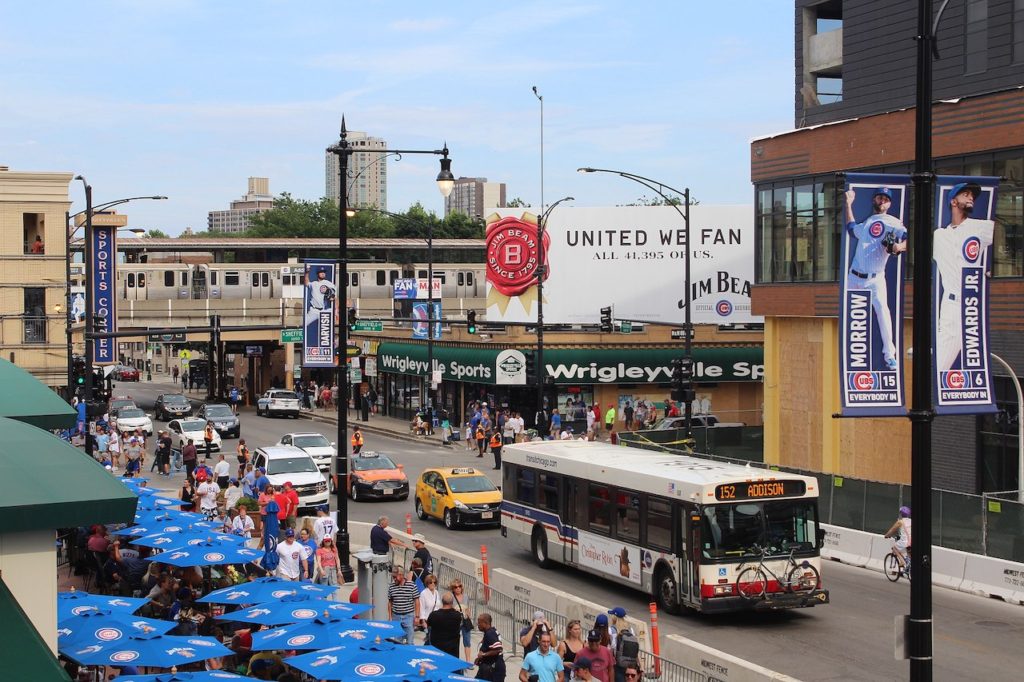
Other routes, like the 10 Museum of Science and Industry, use an endpoint landmark for their name. Still others, like the 2 Hyde Park Express us the name of the neighborhood they primarily service.
CTA Bus Directions
When taking the bus, you also need to be concerned about a bus’s specific direction along a route. Due to Chicago’s grid system, most routes are point to point (not circuitous).
The buses run two directions between the points, and you need to go the proper direction. For example, the 65 Grand runs between Nordica and Navy Pier. To go west, you’ll take the 65 Grand to Nordica.
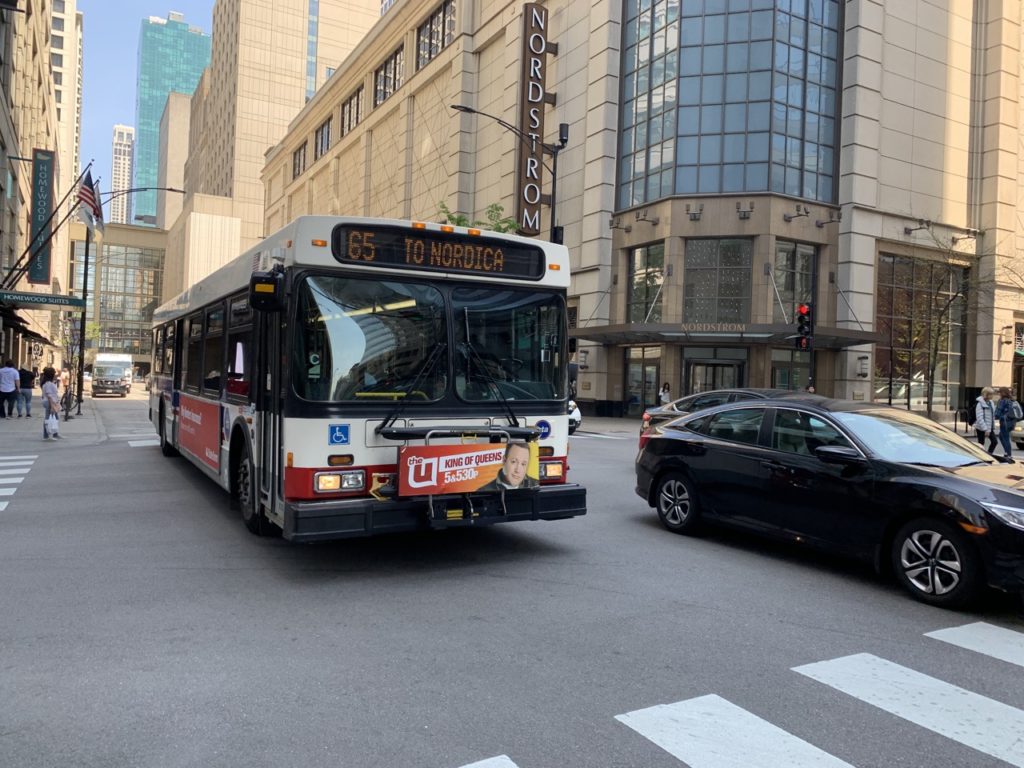
To go east, you’ll take the 65 Grand to Navy Pier.
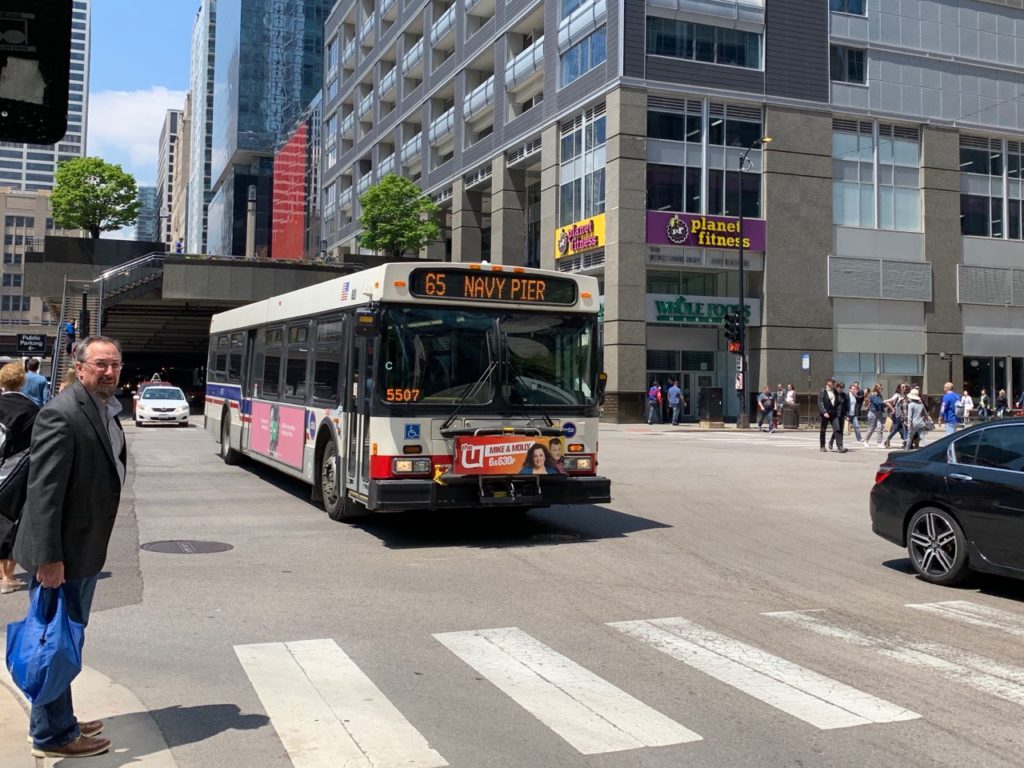
Typically, as long as you’re on the proper side of the street, you can be sure you’re getting on the right bus. But you might not always know what side that is, so here are the three ways to tell.
First, a bus stop sign will indicate the buses and directions that stop at the stop. The below picture, taken downtown, shows, for example, that you’re waiting on the 2 Hyde Park Express North to Navy Pier. Even though the bus is called “2 Hyde Park Express,” you’re at a stop for buses coming from Hyde Park and going to Navy Pier. That bus will not get you to Hyde Park.
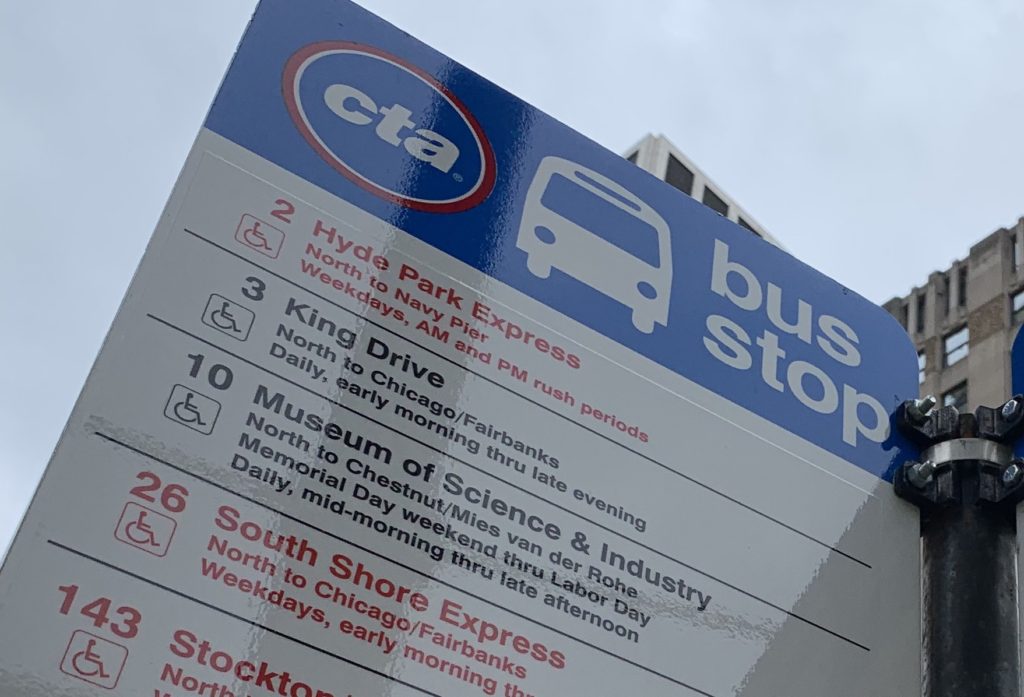
Second, Google Maps places bus stops on specific sides of the street. So if you’re using that service, you can zoom in on the map to identify exactly where your bus stop is.
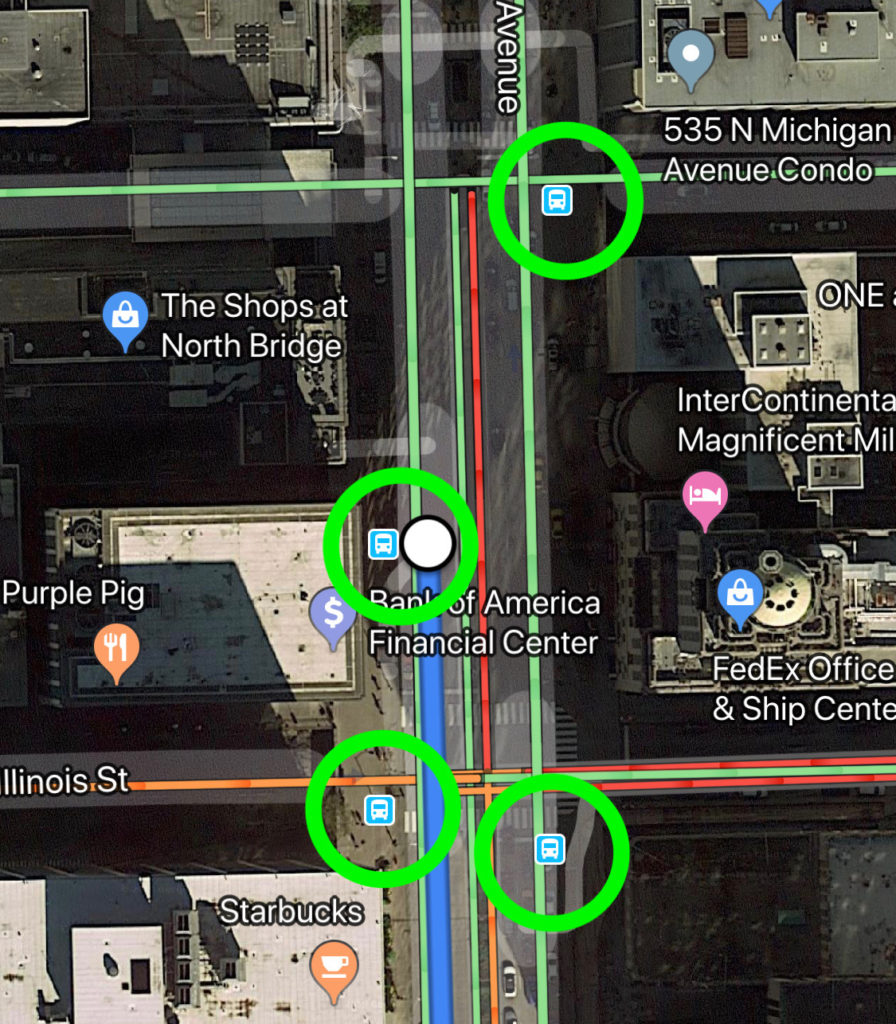
Finally, the buses themselves indicate direction on their front and side marquees. This is a last resort, as you don’t want to find out at the last second that you’re on the wrong side of the street.
As with trains, the endpoints in a given direction sometimes vary. If a bus pulls up with an unexpected endpoint, ask whether the endpoint is before or after your intended stop, or if you’re on the wrong side of the street.
Many buses terminate at or pass through large terminals. For example, the Jefferson Park Transit Station in Jefferson Park is a stop for several buses, the Blue Line, and the Metra. The Navy Pier Terminal in Streeterville is a popular bus terminus downtown.
CTA Bus Numbering
As far as I can tell, there’s no way to make sense of how Chicago’s buses are numbered. The routes are numbered from 1 to 206. Not all numbers are used, and some numbers have multiple variations, like 49, 49B, and X49 (though these variations are easily explained). Some of the routes on the South Side are numbered according to their streets (e.g. the 47th Street bus is numbered 47), but these are exceptions.

For the most part, you don’t need to worry too much about the naming/numbering. You’re usually going to need an outside source (like Google Maps, or a CTA route map) to tell you what route to take regardless. For real transit geeks, we cover more about route numbering and naming below in a section called “Details of CTA Route Numbering and Naming.”
Fares and Payment for CTA Buses
Now we’ll discuss fares (how much the bus costs) and payment when riding the bus.
How much do CTA buses cost to ride?
The fare to ride the CTA bus is $2.25. When paying with cash, the fare is $2.50. Reduced fares are available for certain groups. The 128 Soldier Field Express uses a special $5 roundtrip fare, but I’m not familiar with how this is put into practice.
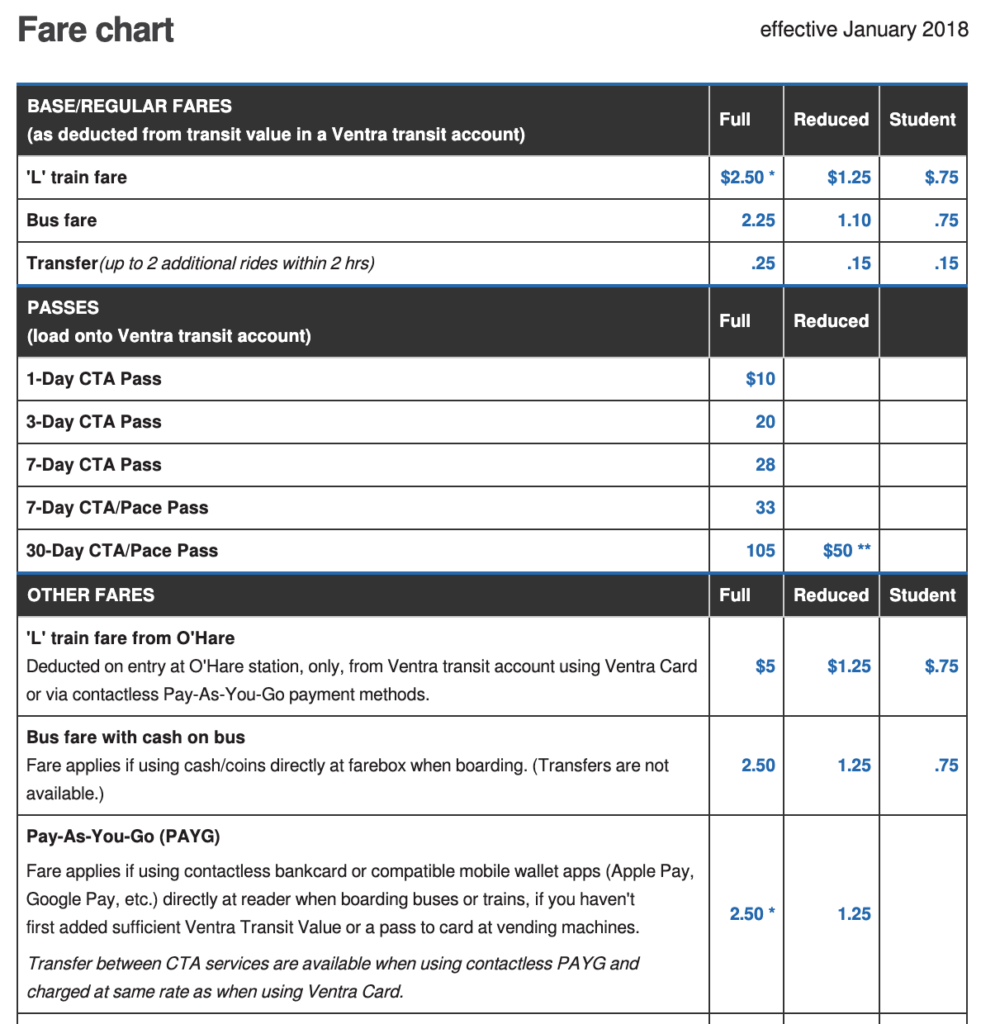
How can you pay for a CTA bus?
There are three ways to pay for a CTA bus—cash, Ventra (card or disposable ticket), or with a contactless payment method (e.g. contactless bank card, Apple Pay, Android pay).
If paying with cash, no change is given. You can pay with cash easily by depositing your coins and bills into the machine at the front of the bus.
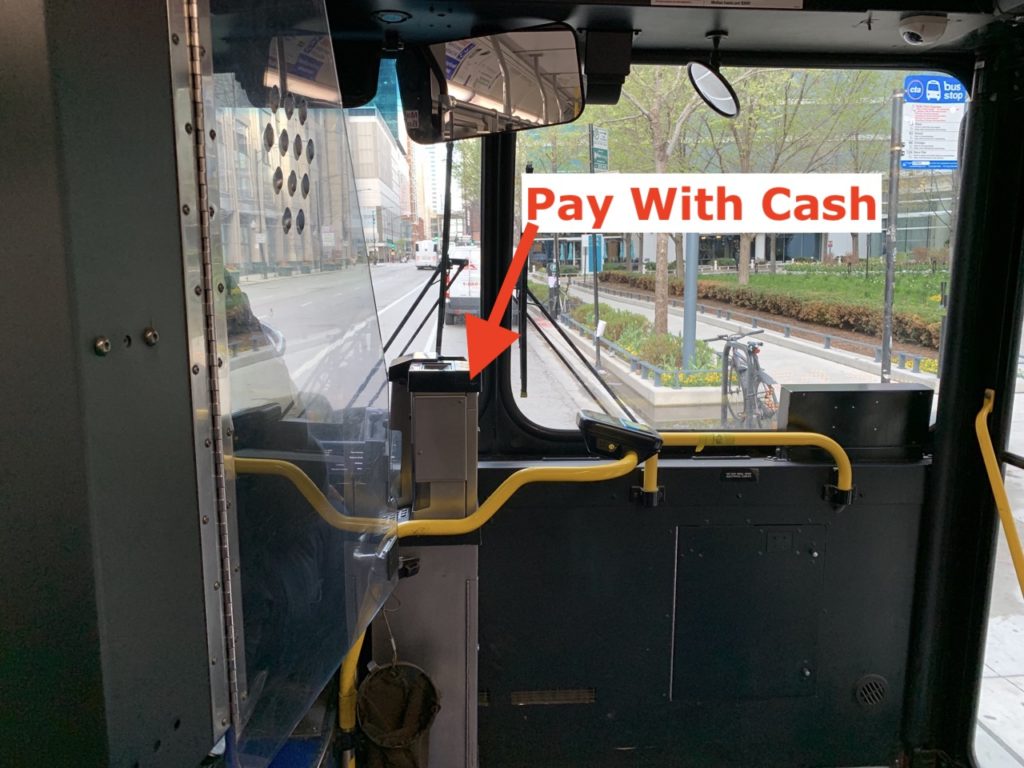
If you’re not paying with cash, you have two options. First, you can use a Ventra Card or disposable Ventra ticket.
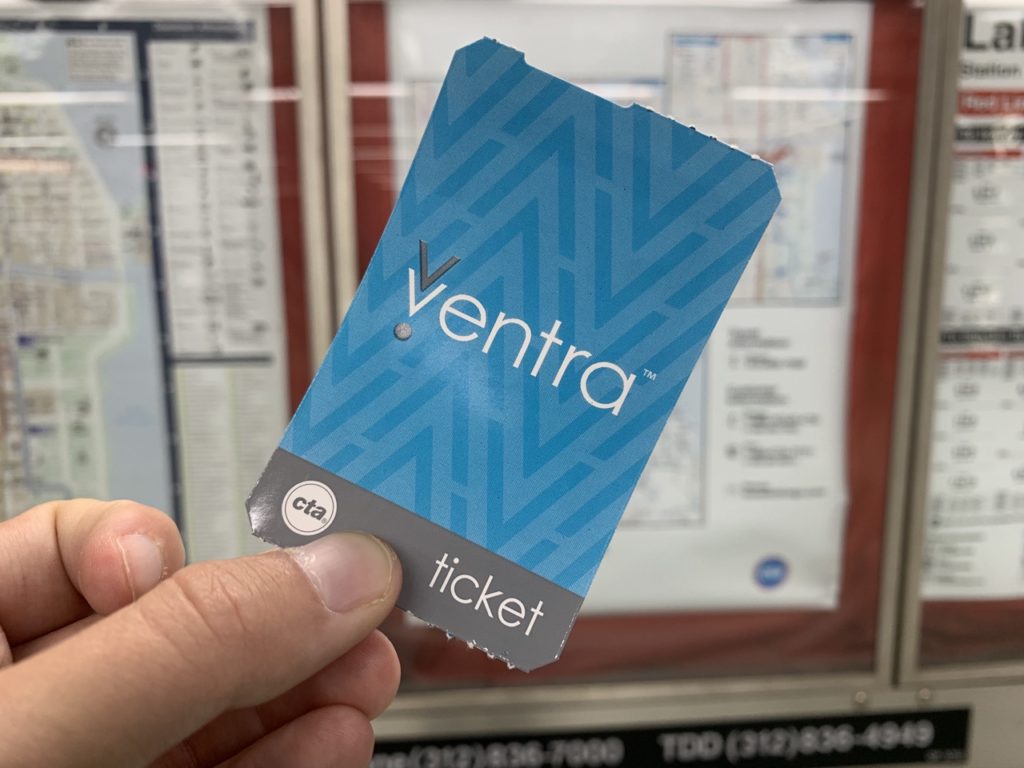
We cover these in detail, including how to acquire them and options for single- or multi-day passes, in our Guide to Riding the Chicago L Train System.
Or you can use your own contactless payment method, like a “tap to pay” bankcard, Apple Pay, or Android Pay.

Simply tap your payment method on the Ventra touchpoint on the bus. It will say “Go,” and you can board the bus.
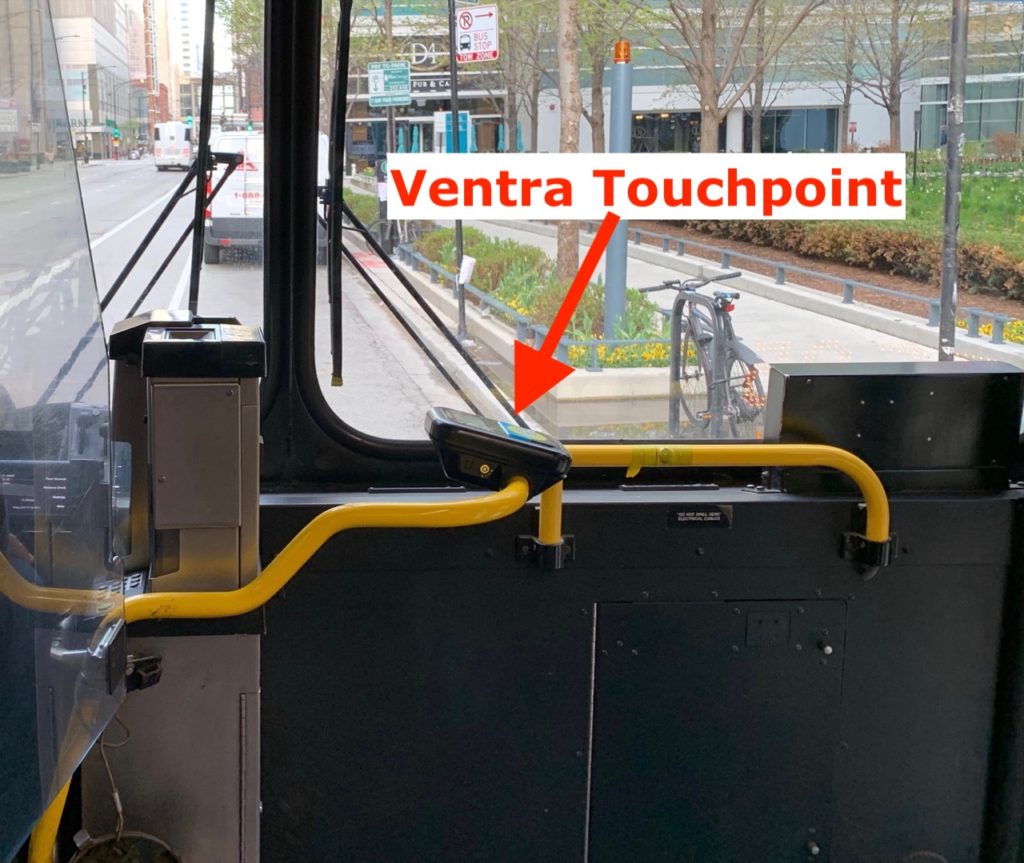
Because Ventra is such a finicky system, we always recommend being prepared with cash as a backup when riding the bus.
Transfers to or from other CTA buses, CTA trains (L trains), and Pace Buses (which serve suburbs) are available. A transfer allows you up to two additional rides within two hours of your first ride for 25 cents total. That is, the first transfer costs 25 cents, and the second is free. You cannot get a transfer when paying with cash.
CTA Bus Tracking
There are a few different ways to track CTA buses. Personally, I prefer Google Maps. Just click the bus stop, click “Buses” and see the times.
An alternative app is “Transit Stop.” I used to use this one, but I’ve never found it intuitive. You can also visit the CTA’s own bus tracker website.
For a more old school method, you can get text alerts. I use this more for bus stops, but you can text “CTABUS [code]” to 41411 to get arrival times by text. The codes are available online and on the bus stop sign (pic below).
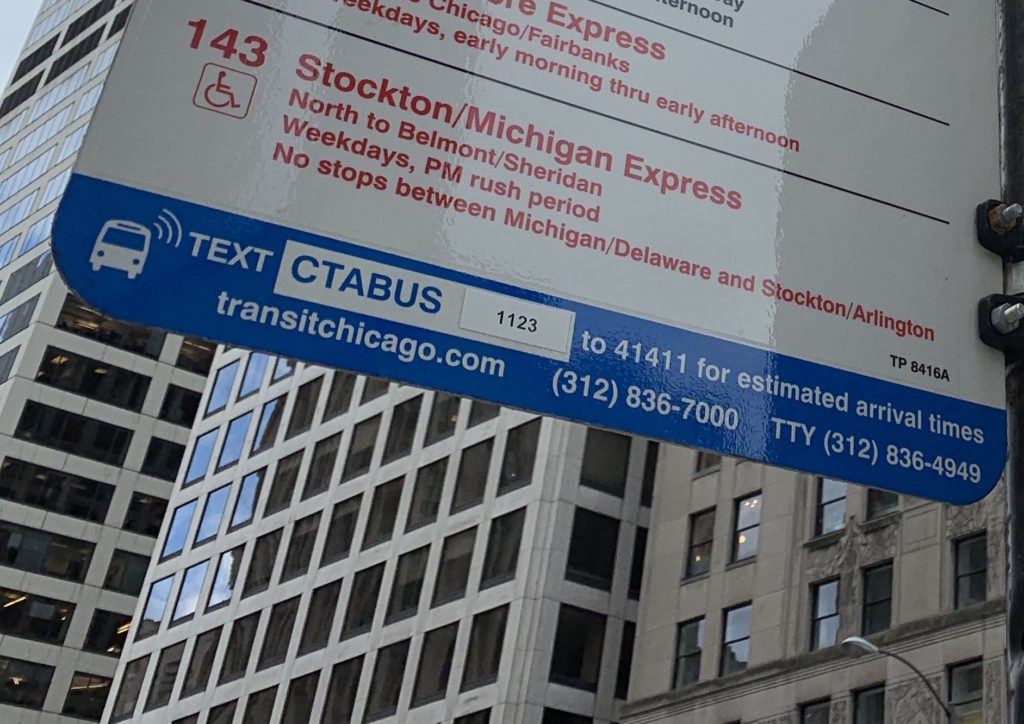
How To Ride The CTA Bus
The first step in riding the CTA Bus is to identify your route options. We recommend using Google Maps, which is also the first suggestion of the CTA themselves if you use their online trip planner. They offer the RTA Trip Planner as an alternative.
Enter your origin and destination into Google Maps. If you’re not traveling now, set your departure time. Review the options. Google Maps use GPS bus tracking to suggest the quickest routes starting from your departure time.
If multiple buses connect the same stops (particularly common downtown, along the Magnificent Mile, for example), Google lists them side by side:
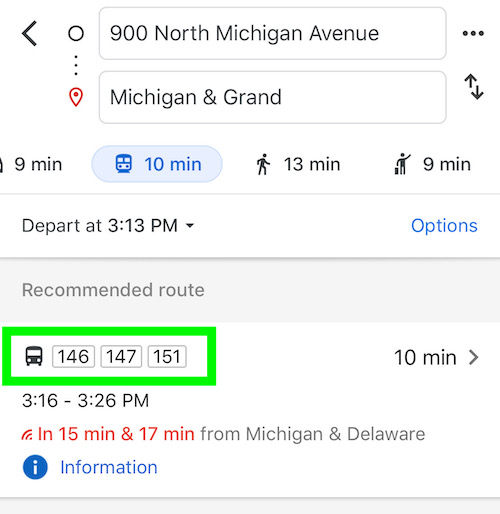
Because GPS isn’t perfect and you might not depart right this second, it is helpful to review all the suggested routes from Google Maps. Using another nearby stop might be better. The below picture shows four options starting at different nearby stops for one trip.

If you’re confused, ask someone else at the bus stop for help. Most Chicagoans are more than willing to assist you. CTA bus signs are also very informative.
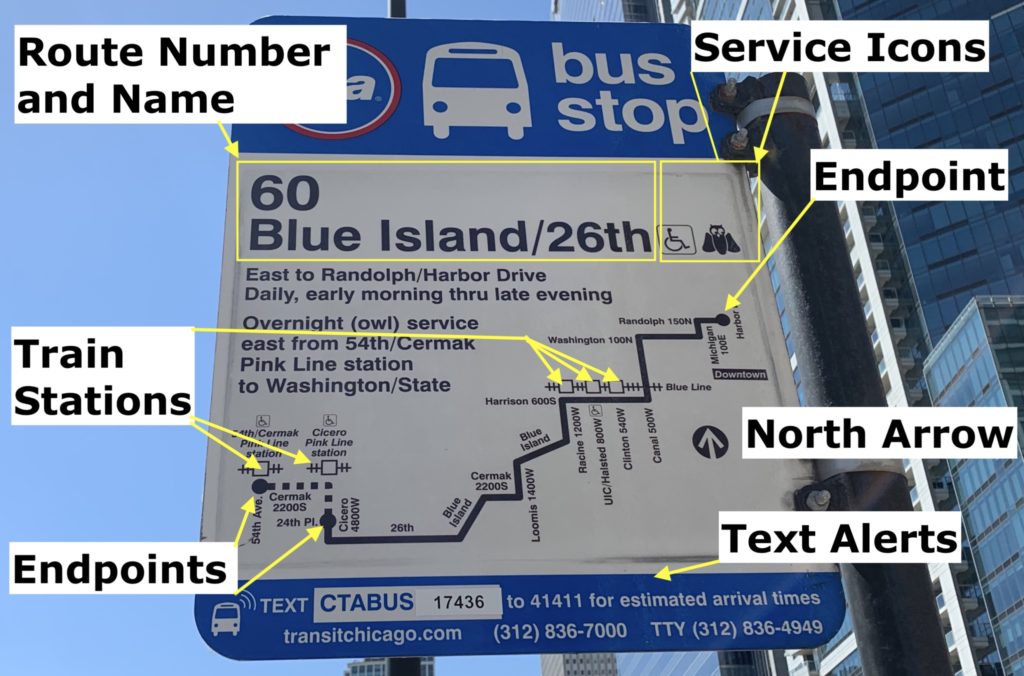
Finally, when in a pinch, you can ask a driver for help. If you’re waiting at a stop and asking a driver for directions, wait for everyone to exit and board the bus before you ask for assistance. Especially in the winter, no one wants to stand outside waiting for you to get directions.
Second, you’ll need to know how you’re going to pay. We covered this in the above section on fares and payment.
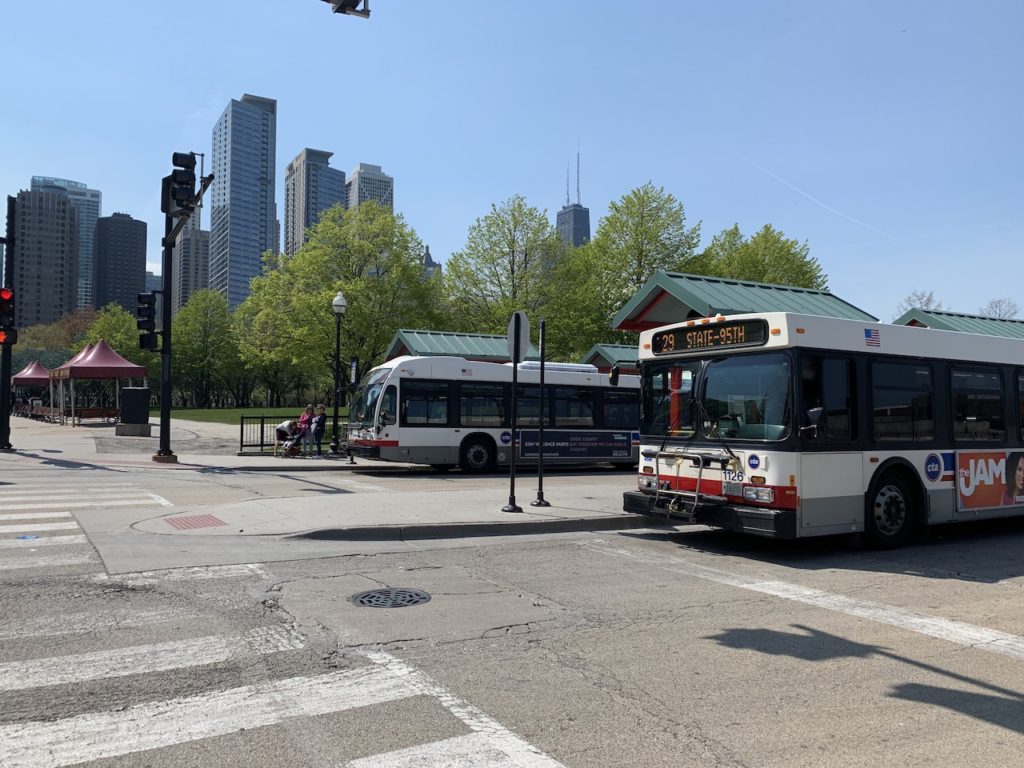
Next, you’ll board the bus. Bus drivers check every bus stop for passengers as they pass them. Simply wait by the sign, and when an oncoming bus sees you, it will stop. Passengers should exit through the rear, but some will exit from the front. Board, pay, and find a seat.
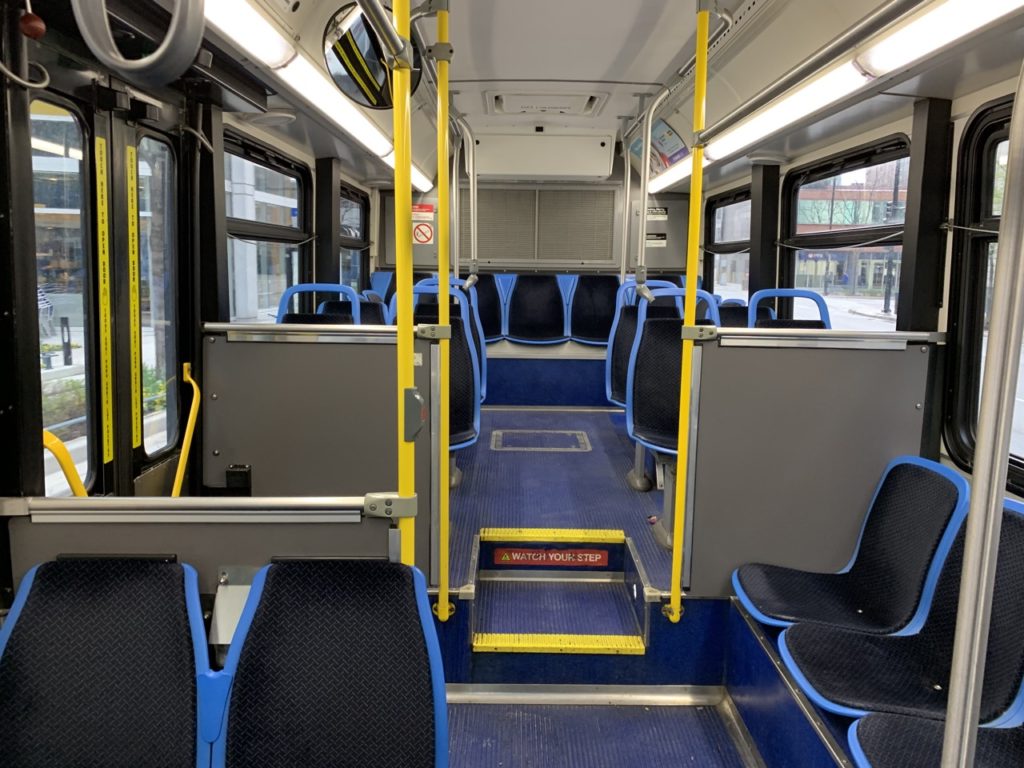
Certain seats are labeled as reserved for the disabled/elderly. You can sit in them if no one needs them, but be prepared to vacate without thinking twice.
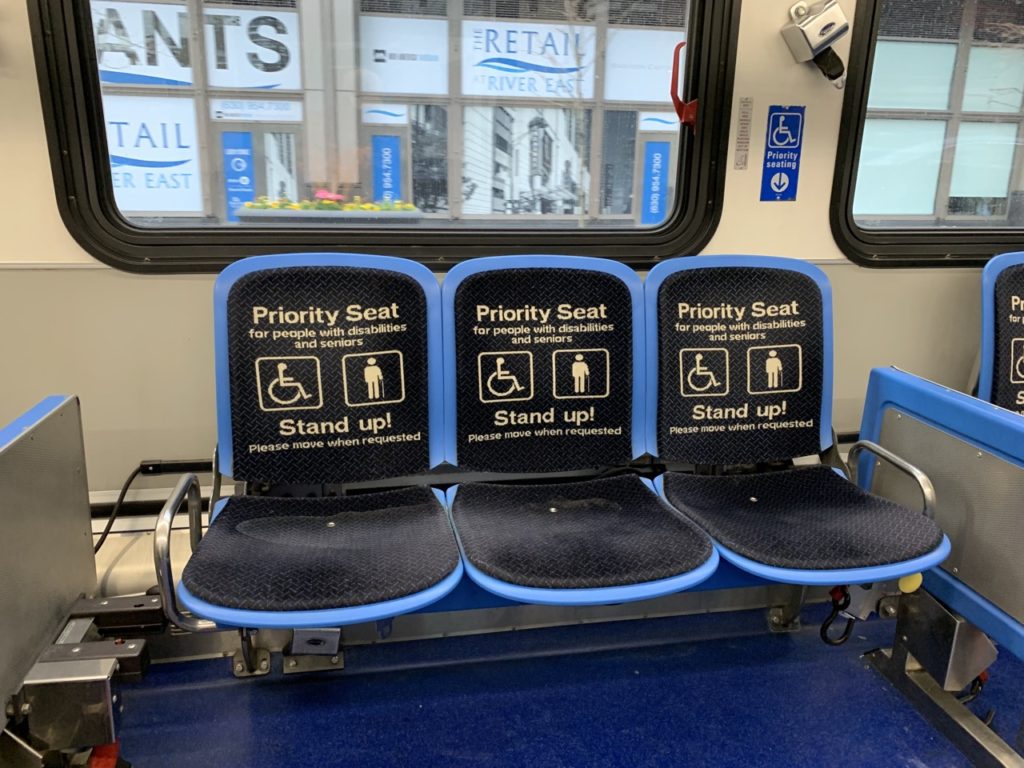
While on the bus, the bus should name the stops one by one. The system isn’t perfect, though, so be sure to check your route on your phone and/or by checking street names out the window.
When your stop is the next stop, pull the cord on either side above the windows, or push the red “STOP” button on some handrails. Once a stop is requested, it is not necessary or possible to request it a second time.

Telling a bus driver your stop when you get on is not expected or even necessarily heeded. It’s up to you to signal the driver when to stop.
If your stop is passed, just yell “STOP, PLEASE!” You’re supposed exit through the back, and there’s no way to request the bus to stop again, so you’re left with only this mildly impolite option.
Basic CTA Bus Etiquette
There’s a lot that could be written about transit etiquette, but we’re going to keep it simple with four points which we’ve sort of already covered.
First, move to the back of the bus. This is essential and something few people seem to understand. Unless you’re an expert on a route and know no one will be getting on, you need to move as far back as possible to allow the bus maximum capacity.
Second, enter through the front and exit through the rear. Not all bus systems in the world operate this way, but most do. You enter at the front, pay, move to the rear, and exit out of the rear at your stop.
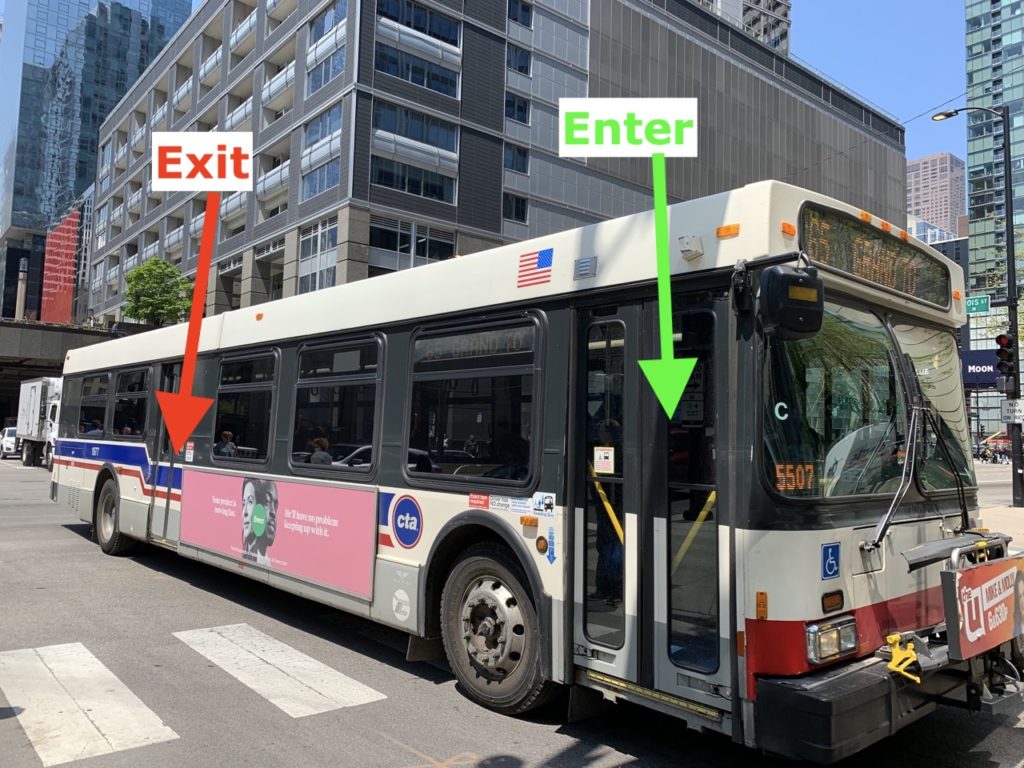
Third, make room for others to sit down. Your bag usually doesn’t need its own seat.
Four, occupy all seats. Offer them to whomever you please, but if a seat is empty it should be filled to ensure the bus can be filled to maximum capacity.
Safety on the CTA Buses
Unlike trains, where multiple trains cars carrying hundreds of people are monitored by a single conductor, a bus is relatively small, which keeps them relatively safe.
You should always be alert to pickpocketing, and you should not stand or sit near a door with any valuables out. If you’re made uncomfortable, move to a different seat and/or alert the driver.

Most of the safety concern for riding the bus comes from waiting at the stops themselves, where you’re something of a “sitting duck.” We don’t want this to be a lecture on safety in the city in general, so we’re going to just give bus-stop specific tips.
First of all, use bus tracking to minimize your time physically at a stop. If you don’t want to wait right at a stop for too long, use bus tracking and either show up just a minute early or wait inside a nearby business until your bus is near.

Second, be very careful at shelters. In particular, do not wait next to a shelter wall that isn’t transparent (like the above Chanel advertisement). This mistake is literally how I got robbed (not in a heavily trafficked part of the city, if you’re worried).
If you’re inside a shelter next to a covered wall, you (1) cannot see the other side of the wall and (2) have absolutely no way to flee once someone comes around that wall and accosts you.
Details of CTA Bus Route Naming and Numbering
This is a bonus section for people who want to learn a little bit more about how CTA routes are named and numbered. It won’t be much use to tourists, but locals should find some valuable information here. We’re going to go through different types of routes with special numbering.
CTA Owl Service
An Owl route is a route that runs late at night. There are two types of Owl routes.
A 24-hour route is a bus route that operates for 24 hours. During late night hours, it may operate a slightly modified route.
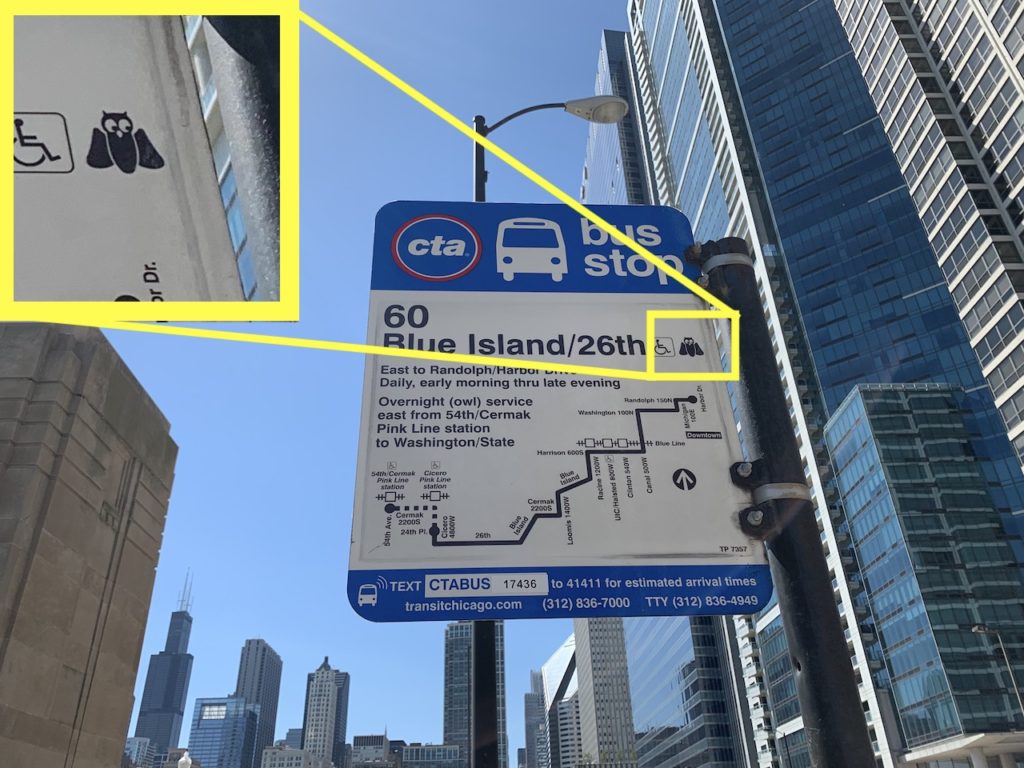
The night buses are designated with an N before the route number on the bus. So during the day, there is a route 4 Cottage Grove. Overnight, the N4 Cottage Grove serves a smaller portion of this route.
The second type of Owl route is a night-only route. The only example we know of this is the N5 South Short Night Bus, which services a unique route during late night hours only. There is no corresponding 5 route. A route with Owl service should also have an Owl icon on the bus stop sign.
CTA Loop Link
Loop Link is not a special type of route, but a special system for getting buses through the Loop more efficiently. Basically, along downtown segments Madison, Washington, Clinton, and Canal, buses use special lanes and stations to expedite transit.
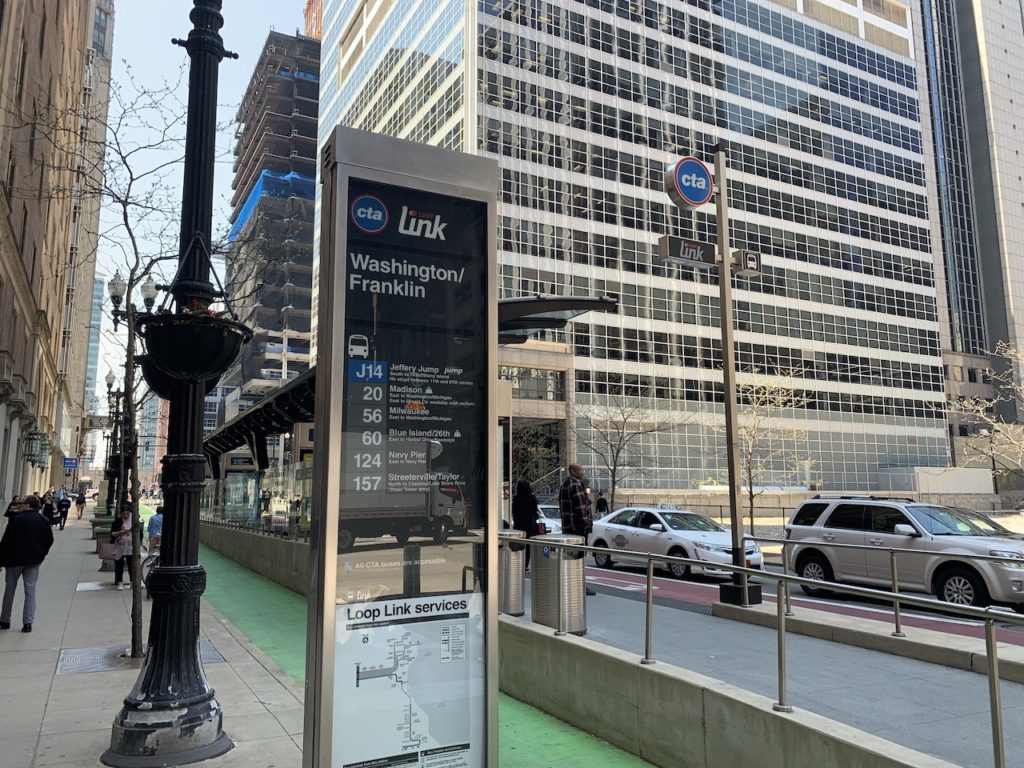
CTA Express and Jump Routes
An Express route is a route that makes fewer than expected stops along its route. An Express route is identified by the use of the word “Express” at the end of the route name, e.g. 125 Water Tower Express.
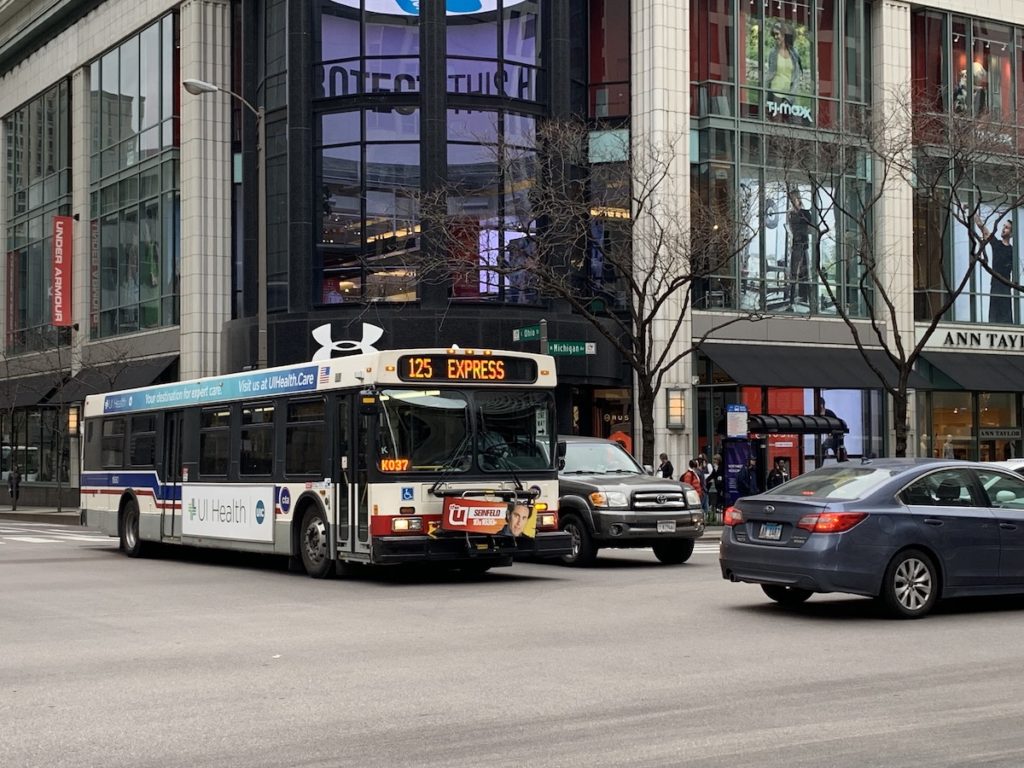
If the route also has a non-express counterpart that makes more stops, the express version will have an “X” added before the route number. For example, there is an express version of the 9 Ashland that is designated the X9 Ashland Express. (Exceptions exist–the X98 Avon does not have a corresponding 98 Avon route.)
A “Jump” service is a special type of Express route. Currently only one exists, the J14 Jeffrey Jump. Besides having typical Express characteristics, the “Jump” feature uses special traffic lights to allow the bus to jump ahead of other traffic at intersections.
CTA Extension Routes
There are a variety of routes that use “A / B” numbering to indicate routes that extend another route. For example, there are three Cicero buses: 54 Cicero, 54A North Cicero, and 54B South Cicero. The 54A and 54B routes overlap with the 54 Cicero route a bit at its ends, but essentially these routes extend the main route a bit via a transfer.
Other extension letters are sometimes used to designate routes that take special paths along different streets, like the 55A and 55N which use portions of Austin and alternatively Narragansett.
